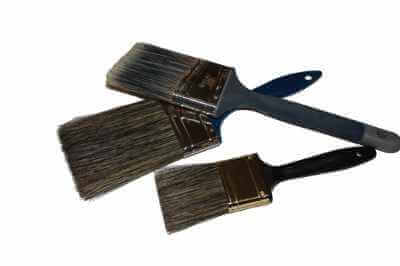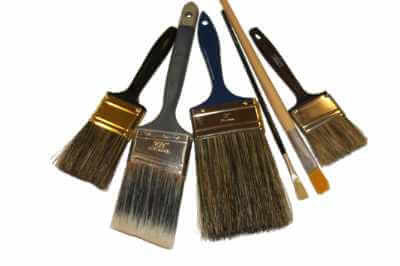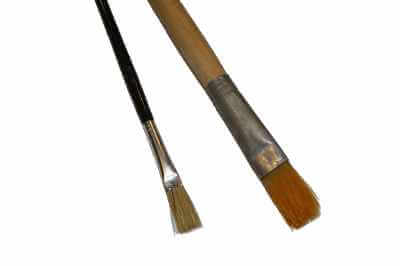Choosing Brushes for House Painting
by: Dale Cox

For painting projects around the house, you really only need 2 or 3 "good" paint brushes. Even if you need to paint every room in the house and the entire exterior too, you will likely want just a few favorites to do it all.
Good, professional-grade paint brushes aren't cheap. A basic high-end, 2 inch brush will start at around $15.00. This may seem like a lot to pay but as long as you wash it properly after each use, a brush like this will last through many years and painting projects. In reality, a quality brush will be much cheaper in the long term than a low-end one.
Inexpensive brushes aren't so cheap, starting at around $5.00, and given that they will make it impossible to do fine work and the cheaper components will break down quickly, you will be buying several in a short period and end up fighting to achieve even minimally acceptable results. The frustration factor alone is enough to make a quality brush worth the price.
Evaluating Paint Brush Quality
Quality is very important in paint brush choice if you want to achieve a smooth finish. Natural fibers or synthetic, quality will vary greatly from low-end to premium brushes. When it comes to premium, professional-grade paint brushes, you'll have to visit a paint store to get one. Home stores simple don't carry these high-end brushes, the best you will find is a second tier product meant for home owners and do-it-yourselfers. So if you have a lot of trim painting to do, especially with glossy paint, you will really want to have a professional-grade brush to make the job easier and get topnotch results.
At your local home store you can usually determine brush quality at a glance by the price. To evaluate quality beyond price, examine the brush bristles closely. Hold them in your hand and flex them back and forth. A quality brush should have bristles that move freely in both directions while keeping a uniform shape. The tapered ends of the bristles should form a straight, consistent line in all positions. The whole brush should move in unison and spring back with ease.
If the filament is too floppy or too stiff, the brush will be hard to use. If the bristles separate and look uneven along the end, it will be very difficult to paint a straight line and a consistently smooth paint coat will be impossible to achieve on trim molding and other smooth surfaces.
Paint Brush Construction
Natural-bristled brushes for house painting are made using hog hair and ox hair. Most of these brushes found in home and paint stores are made with the hair of hogs from China and are called China Bristle brushes. These 100% hog hair brushes come in two colors, black and tan. The black China bristle brushes are cheaper and tend to be stiff as compared to the tan ones. This makes black China bristles a good choice for the rougher surfaces around the house in need of oil paint like fencing and decks. Tan China bristles are softer and better for achieving a smooth finish with glossy enamels and clear coats. This makes them a good choice for painting finer surfaces like wood trim moldings, builtins, and cabinets.

A step up in quality from 100% China bristle is a blend of hog and ox hair. These are going to be more expensive and not worth the extra price unless you have a very special project in mind like high-gloss varnish over natural wood surfaces on furniture or cabinets. Also, even more expensive, 100% ox hair brushes are available for specialized coatings and faux finishing projects like marbling and woodgraining.
Synthetic bristles are made using nylon, polyester and acrylic. The quality of synthetic-bristled brushes will vary greatly depending largely on the material used to make them. Low quality bristles, also called the filament, are hollow and very light. They tend to splinter and don't hold paint well making it very difficult to achieve a smooth coat of paint, particularly when using glossy finishes. Other components of these cheaper synthetic brushes include ferrules -the metal band holding the bristles to the handle- made using ferrous metals that tend to rust when exposed to water and plastic handles that are cheaper than wood.
A good quality latex brush is usually a blend of nylon and polyester fibers. The bristles on these brushes are solid, as opposed to hollow, and tapered at the ends to aid in applying a smooth paint finish. Nylon/poly blends like this are very common for higher quality latex paint brushes. Other features of a high-end synthetic brush include ferrules made with stainless steel or other non-rusting metal and wooden handles that standup to repeated washing.
Choosing the Right Brush

To choose a brush for house painting, first consider whether you're using an oil or water-based coating. The type of coating will determine the type of bristles to use. As a general rule, you will want a natural-bristled brush made with animal hair for oil or alkyd paints and a synthetic-bristled brush made with nylon and polyester for water-based latex coatings. These natural and synthetic fibers react differently to oil and water making each suitable for one type of coating but not the other.
Natural bristles don't perform well with latex paints as they tend to absorb water, getting overloaded and flopping back and forth instead of springing back between strokes. Natural bristles are best for spreading oil coatings without brush marks in the finish. Synthetics are better suited for water-based coatings, holding latex paints well and delivering a smooth consistency in the coat. An exception to this rule is a synthetic material called Chinex® developed by DuPont® as an alternative to natural fibers for oil coatings, that can also be used for latex paints.
While you can use a Chinex® brush for both types of coatings, you should not use the same brush to apply oil-based paints and then use it to apply latex paint. Once you've used a brush for oil, you'll want to dedicate it to oil paint if you intend to use it for that purpose again in the future. Oil brushes will always retain some residual solvent in the filament that will bead up with the addition of water, causing problems. This will also make it difficult to completely clean the brush when you're done.
Conversely, if you want to use a Chinex® brush in oil paint after you've used it for latex, that will work. A few days after washing a latex brush, all the water will have evaporated and the brush can be used for oil-based coatings without any problems. Of course, after that it should become a dedicated oil brush for future use.
How Many and Which Ones?
If you're going to be doing a lot of painting projects around the house, you should definitely invest in a couple of good quality brushes. Because most house painting jobs involve latex coatings, premium nylon/poly brushes are your best choice.
For all your walls, ceilings, exterior siding and even most trim moldings, a high-end 2½ or 3 inch angled brush will be the go-to tool. For smaller features like window sashes and thin strip moldings, a 1 to 2 inch angled brush will do the job. Lastly, if you need to apply oil-based paint, primer, or clear coats, a 2½ to 3 inch angled China bristle brush will serve these needs well.
Paint brushes with the bristles cut at an angle make for the most versatile tool to use on nearly every surface around the house. These brushes are intended for painting window sashes because they are easy to control with precision and are often called sash brushes. But once you've used one of these, you'll likely want to used them for everything. The angled cut makes it easy to reach into tight corners and paint along borders to produce crisp, clean lines and sharp points. For painting broad surfaces like wood-lap siding and door panels, the slant of the bristles make it easier to draw the brush in even strokes with minimal effort. This ease of movement produces a smooth finish in the coating without leaving unsightly brush marks behind.
In addition to an angled cut, also look for a tapered tip on the bristles. Brush bristles may be cut off squarely at the tip, or they may be cut to a gradually tapered tip. You can recognize a tapered bristle at a glance as the color will be lighter along the ends where the filament is thinner. A tapered bristle makes it easier to load and hold paint in the brush. It also makes controlling the flow of paint as you stroke easier, producing a consistently smooth finish in the coating. High-end brushes for house painting will always be tapered at the tips while cheaper brushes are usually cut off squarely.
While the shape of the bristles can make a tremendous difference in the finished work, you should also consider comfort when choosing your brush. To cut-in on walls and ceilings for instance, you will want to use a wider brush than for painting window panes and other small features of a room. A 3-inch filament is a good choice for painting around corners before rolling the larger spaces of a room. Any wider, and the brush can become heavy and hard to manage overtime as your hand becomes fatigued covering these large areas.
Brushes for Odd Jobs
In addition to a few high-end brushes, you will likely need one or two other, lower quality brushes around for rough work. For example, there are certain surfaces around the house that may call for a paint brush that can be "ruined" such as cast iron radiators. Painting these old radiators requires pushing paint into crevices and corners that will quickly bend the bristle out of shape making the brush unusable for any other fine painting work. However, a "radiator brush" will remain good for other rough work like fence painting or applying deck sealer, etc.

Another special brush you may be glad to have is an inexpensive long-handled art brush with a 1/2 or 3/4 inch-wide bristle. One of these can be invaluable for small touchup jobs when you just need a dab of paint here and there. Or if you have to reach into a cramped space to apply a bit of paint, a brush like this can be a lifesaver.
There may also be times when you'll want to keep a dedicated brush sealed inside a paint can to avoid the difficult process of cleaning it just to use it again in a short while. For example, when you need to seal stains on a wall surface with an oil-based sealer like Kilz®, it would require a long, messy process and lots of paint thinner to clean the brush out each time.
These primer-sealers dry very quickly making it impossible to preserve a paint brush unless you clean it out immediately. Keeping the brush submerged inside the sealed can will preserve it for future use without the hassle of cleaning or the expense of a ruined brush and the need to buy another one to apply more sealer in the future.
When you need to apply sealer again just pull the brush out, wipe the paint from the handle back into the can, and you're ready to go. Wearing gloves or using a rag to hold the brush until you get it clean will keep the sealer off your hands. One note: most brush handles will be too long to fit inside a paint can. You will have to cut the handle short enough to fit or buy a brush with a stubby handle to be sure it will fit when the lid it replaced on the paint can.
One other brush to keep on hand is a chip brush. These are small, natural bristle brushes that are good for really rough work. Anytime you need to apply an oil-based or other hard-to-clean coating like sealer, waterproofer, adhesive, or a polymer for protection and not appearance, a chip brush will make life a lot easier. Because they are inexpensive and made to be disposable, you don't have the hassle of dealing with it once you're done with the project. One disadvantage of a chip brush is it is disposable, meaning adding it to the landfill. The saving grace with these is they are usually made with biodegradable materials including animal hair, ferrous metals, and wooden handles. So if you choose to use a chip brush, avoid those made with plastic handles so it is truly biodegradable. You could also just wash a chip brush like any other and use it again to avoid throwing it out.
Keeping Your Brushes in Top Condition
To protect your investment, be sure you know how to effectively wash your paint brushes or they will be ruined in short order. Once the base of the bristles are clogged with old paint, the brush will not flex properly any longer. The lack of flexibility will make applying a smooth coat of paint next to impossible. A ruined brush like this will be no more useful than a $1.00 chip brush for fine work.